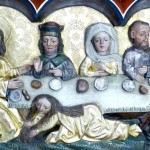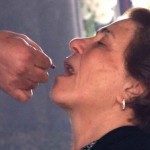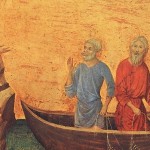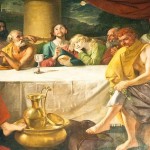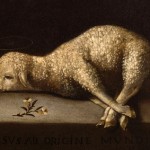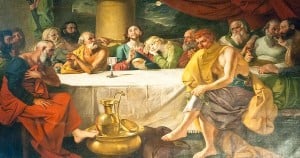 One of my favorite painters is the surrealist Salvador Dali. In 1976 Dali painted a painting titled “Gala Contemplating the Mediterranean Sea which at Twenty Metres Becomes the Portrait of Abraham Lincoln,” (commonly called “Lincoln in Dalivision). In this painting, he used 252 tiles that, when seen up close, look like his wife, Gala, looking out a window, with other images thrown in. But as you move back from the painting, a picture of Abraham Lincoln emerges. Not long after this, the world of photo mosaics was born.
One of my favorite painters is the surrealist Salvador Dali. In 1976 Dali painted a painting titled “Gala Contemplating the Mediterranean Sea which at Twenty Metres Becomes the Portrait of Abraham Lincoln,” (commonly called “Lincoln in Dalivision). In this painting, he used 252 tiles that, when seen up close, look like his wife, Gala, looking out a window, with other images thrown in. But as you move back from the painting, a picture of Abraham Lincoln emerges. Not long after this, the world of photo mosaics was born.
And that’s what the Gospel of Matthew is like. The entire meaning of the Gospel, the Good News, is about to be revealed in a startling way so that all of those wonderful individual pictures Matthew’s been showing us now reveal themselves to be part of a much larger picture.
For several chapters, now, Jesus has been teaching about the coming of the New Covenant and the cataclysmic events that would usher it in. He actually began teaching about it in the very first words of His public ministry: “Repent, for the kingdom of heaven is at hand” (Matthew 4:17). He then proceeds to talk about the Kingdom and the blessings it will bring upon those who are poor in spirit and who hunger and thirst for righteousness, after which He teaches about the new Law in the New Covenant. He demonstrates that there is a new power in this New Covenant by the many miracles He performed.
In choosing the 12, He prepares for the continuation of this New Covenant after He must die and be raised up and then ascend into heaven. He tells parables about what life in the kingdom will be like, and He miraculously feeds both the 5000 and 4000 as a way of teaching about how He will feed those who hunger after righteousness in the New Covenant.
Beginning in Chapter 16, He begins to teach about a terrible price that must be paid in order for this New Covenant to be put into place. That price is His own life, which He will give for the life of the world, and it will involve a sacrifice on the part of His disciples as well. He teaches some more about the coming of the New Covenant, teaching in many different ways that Israel of the Old Covenant has rejected her Savior, killing the prophets and soon the Son Himself. His harshest words are for the leaders of Israel, who should have prepared the people and led them to the Messiah and the New Covenant but who instead are determined to keep the people in great darkness. And then He teaches about how terrible the events will be that mark the fullness of the coming of this New Covenant.
Here in Chapter 26, when we come to the Last Supper and the institution of the Lord’s Supper, suddenly the entire book of Matthew comes into focus. Each of the stories and teachings we have heard are all part of the larger picture of the coming of the New Covenant and the coming of the Kingdom of Heaven. But it’s not until we come to Matthew 26 that things start to make more sense. The Lord’s Supper bridges the gap between Jesus’ teaching about the New Covenant and it being put into effect. It’s amazing how short the account of it is. It would look rather unobtrusive, if we weren’t already alerted to its immense significance. In Matthew’s account, he spends 9 verses talking about the preparations for the Passover and the coming betrayal of Him. The description of the actual supper lasts only 4 short verses, and then Jesus and the disciples leave for the Mount of Olives.
It all happens so quickly, that it would be easy to miss. O.K., so Jesus is at the Passover with His disciples. We would expect that, since this was a required feast, and we’ve heard about Jesus going to Passovers before. We’ve been hearing about Jesus being betrayed and going to die and then being raised up on the third day for some time, and it seems time to get the inevitable over with. We all know that Jesus has to go into Gethsemane to pray and be betrayed and then experience the terrible events of the Passion and Crucifixion.
So why this interlude with the disciples at the Passover? It’s just a religious obligation, and one that was part of the Old Covenant, isn’t it?
But these 4 verses are not only what connects the parts of Matthew’s Gospel: they’re also what connects us to Matthew’s Gospel and the narrative of the coming of Christ and the New Covenant. Just as Jesus had gathered up His chosen 12 apostles to be His Body and continue the work of the Incarnation, now He also provides the means by which they will continually be fed and strengthened to be His Body and do His will on earth. In the Lord’s Supper He gives Himself to them for heavenly food, the bread which comes down from heaven. In this supper, He gives Himself to them, His Body and His Blood, that they might become His Body and be one with Him.
Having established His Church and given Himself to her by His supper, He also made it possible for that Body to continue to live and be one with Him, even after the 12 were dead. In this humble supper, He seals the New Covenant for all time, even as all of the Old Covenant is consumed and fulfilled within the New Covenant. All of the sacrifices of the Old Testament and all of the feasts and festivals are contained in this humble meal. All of the Gospel, from the Incarnation in which the Father gives His Son and His Body and Blood for us to the Crucifixion to the Resurrection and the Ascension, are served to us, here in this humble fellowship meal.
Here is the Passover Lamb, the Lamb of God that takes away the sins of the world. Here is the meaning of all that God had told Israel 1500 years before, and here is the meaning of our lives 2000 years later.
Here is the betrayal of mankind, Adam’s sin being repeated by Judas, and Adam and Judas’ sins being repeated by us. But here also is the sacrifice that takes away the sins of the world, for all who eat with faith. Here is the Crucifixion of our Lord for our sins, and here is our own death. But here also is His Resurrection and our new life with Him.
This humble supper is the fulfillment of the Passover and the prediction of the Crucifixion. It is the fulfillment of the Incarnation, and the prediction of the Resurrection. For us, it is the fulfillment of all, because in it we find Christ. In it, we remember God’s promises and mighty deeds and we anticipate the future hope of glory. And in it, we come to understand the meaning of the narrative of our lives and all of the smaller images that sometimes don’t make sense by themselves.
It would be easy to read these 4 small verses and pass by as if nothing particularly significant had just happened. It would be easy to read them quickly and without due attention because we’ve seen it all before.
But here is the meaning of our lives. Here is the New Covenant. Here is Jesus Christ, His life, His Body and His Blood, offered to us anew, each and every time we come to this humble supper.
So now is the time to prepare for the next time you come to this supper. Do not treat it lightly. Do not pass over it, as if it were nothing. For in it, is Life itself, for in it, is Jesus Christ, who is the New Covenant and all its blessings.
Prayer: Almighty God, whose blessed Son Jesus Christ has ordained in the Holy Sacrament the perpetual memorial of His death and the communion of His risen life; grant that when in obedience to Thy command, we keep the feast, we may approach Thy table with love and humble hope; that, discerning its sacred mystery, we may feed by faith upon His Body and Blood, and be made partakers of Thy heavenly grace; through the same Jesus Christ our Lord. Amen.
Points for Meditation:
- If you are in anguish because of sin or difficult circumstances, remember the heavenly food Jesus offers to you at this time.
- How might you more adequately prepare to eat the Lord’s Supper the next time it is offered to you?
Resolution: I resolve to prepare adequately for the next time I come to the Lord’s Supper.
Last Supper – Creative Commons Attribution-Share Alike 3.0 Unported license

